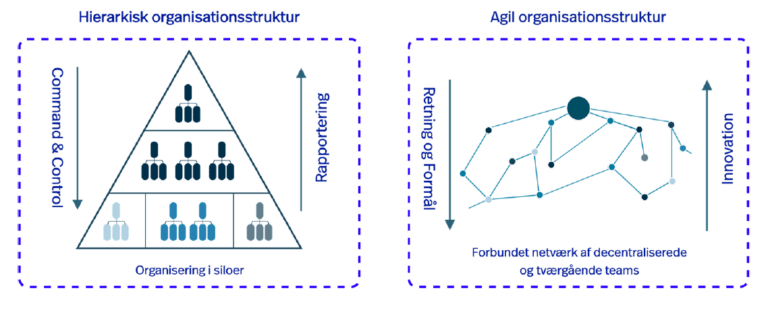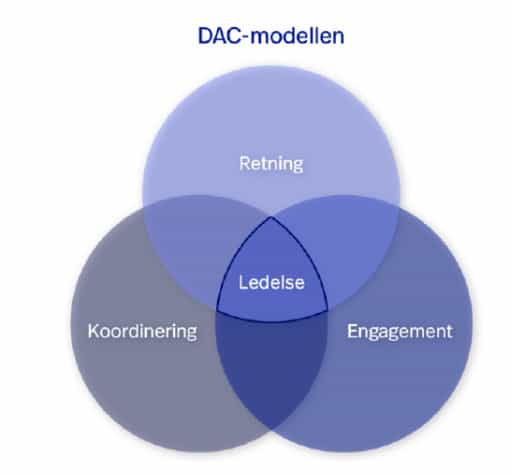What is agile transformation? The potential and idea of an always competitive and adaptive organization may seem promising, but few people realize that it requires much more than 'just' adopting new agile ways of working, roles and structures. It requires a fundamental departure from a management culture whose history stretches all the way back to the roots of industrialization. In this article, we focus on leadership as a fundamental concept and argue from a leadership theory perspective that agile organizing requires a new leadership model.
More than 100 years ago, Frederick Winslow Taylor founded the principles of how organizations should be structured to efficiently produce standardized products on standardized assembly lines through standardized tasks and processes in standardized departments (Taylor, 1911). Organizations were built in pillars with management at the top and employees at the bottom, resulting in the traditional hierarchical organization as we know it. The good employee was obedient and punctual, and management, to put it bluntly, was reserved for the manager, first as manager-of-employees, then manager-of-managers, manager-of-function and finally top manager. In other words, it is a basic premise of this organizational form that management = leader, and that leadership is hierarchically based on a specific person who has been granted the right to 'lead', often through the traditional command & control approach, which is incredibly effective at streamlining standard processes, reducing variance and removing risk in a relatively stable environment.
In 2001, the agile manifesto was published, which really kicked off the accelerating transition to agile organization, whose working methods, structures and leadership styles are in many cases the direct opposite of traditional hierarchical organization and management. Here, creative processes, a proactive mindset and iterations are valued, and leadership is about setting direction and giving employees far more autonomy, making sure they have the time and resources available to do the job themselves, often referred to as 'servant leadership' (Greenleaf, 1970).
The article continues in the next section.

Curious for more? Download our agile management e-book
In this e-book, you will learn what characterizes agile leadership, not as a one-sided and simplistic leadership skill, but as the ability to balance your leadership in the context in which you lead, and that this form of leadership is not only relevant in pure agile organizations, but for any leader who must navigate in a world of increasing complexity and uncertainty.
In the agile organization, the entire starting point of the traditional organizational structure changes, and many organizations overlook in their transformation process to an agile organization that the leadership model, which is typically deeply embedded in the culture, must also be radically transformed to succeed. The approach to leadership must reflect the organization that needs to be led, and therefore, in the agile organization, we also need to change the starting point of 'leading' itself.
In the illustration below, the difference between hierarchical and agile organization is visualized in two individual models. In the hierarchical model, management is linked to specific people in formal management roles and is primarily top-down in a series of pillars that report management communication back up the management chain as a basis for decisions. In the agile model, leadership is much more distributed across a number of autonomous and cross-functional teams. The role of top management is not so much about managing and controlling through detailed instructions and extensive reporting. It's about giving direction and meaning to top priorities and key results so that autonomous cross-functional teams can create value for customers and drive innovation. Top management must ensure that the organization has the capabilities to remain relevant and competitive at all times in an increasingly turbulent market (Rigby et al., 2020).

With the clarification of the two organizational forms and the associated implications for management, we now take a closer look at the problem of adapting management from a hierarchical to an agile organizational structure from a management theory perspective.
What is leadership and how is it different in an agile setup?
The first question we need to ask ourselves is what does it really mean to 'lead'? We usually have no trouble identifying 'a leader', but what underlying elements and abilities are actually present in order to talk about 'leading'? We need to clarify this before we can focus on how leadership in its basic substance should be viewed in an agile organization.
The common view of leadership typically leans on what has been called the 'tripod model', where leadership consists of one leader or leaders, one follower or followers, and one common goal that they work together to achieve (Bennis, W.G., 2007). In this view, the idea of 'leadership', as introduced in the introduction, is grounded in one or more elected individuals exercising leadership over their employees/followers. Logically, this form of management fits well with the classic hierarchical management model, where employees are not expected to think creatively and be self-directed, but instead are expected to perform standardized tasks under management control with a focus on minimizing risk and variance in a relatively stable environment. In this case, the structure is mirrored in the management style, and on the corresponding premises, you have an effective organization.

However, most organizations have come to realize that the above premises are no longer valid and that the tripod model is not enough for organizations to be competitive and able to adapt quickly to changes in the market.
It is against this backdrop that the idea of 'agile' has emerged, and as a result, a vast amount of literature has been written on agile organizational structures and working methods, but when it comes to the literature on the requirements for leadership transformation, it is often limited to specific leadership competencies such as 'servant leadership' (Greenleaf, 1970) and the ability to create 'psychological safety' (Edmondson, 1999). However, very little has been written about the requirements for the shift in how leadership at its core needs to be thought of differently, and if you are not aware of these requirements, you will undeniably face significant challenges. If, like many organizations, you embark on a thorough agile transformation but keep management stuck in a tripod mindset of leadership, the leadership will no longer reflect the organizational structure to be led, often resulting in conflicts and, in the worst case, the transformation itself failing. We must therefore return to the initial question of what leadership really is and how to create a model that fits and reflects an agile organization.
Another perspective on leadership comes from the Center for Creative Leadership, which describes how leadership instead occurs when three elements are present simultaneously: Direction, alignment and commitment, also known as the DAC model. In other words, when a group of people in a given situation succeed in working together in a coordinated and committed way in a meaningful direction, this is leadership. The key point here, in contrast to the tripod model, is that the definition of leadership does not require an individual to lead and others to follow, but simply that these elements together create leadership.

This model of leadership is much more reflective of the fundamental element of self-direction and autonomy required in the agile organization. There's no point in all the power of leadership being centered in individuals who see themselves as leaders and their employees as followers, as this would be directly contradictory and stifle creative processes and the desire to act proactively. Instead, if you start from the premise that leadership requires the presence of direction, coordination and commitment, a new leadership situation emerges where leadership ≠ manager, but where leadership can instead be seen as a process that everyone takes part in and is responsible for.
For the record, it should be emphasized that agile leadership is not the same as being leaderless (Laloux, 2014). There are clearly defined leadership roles when organizing according to agile principles, but as previously described, these roles are more about supporting the autonomous teams' ability to succeed rather than engaging in classic command & control leadership. Everyone, based on their respective roles, is expected to take proactive co-responsibility for working in a committed and coordinated way towards the common direction.
Based on the premise that leadership must reflect the current organizational structure in order to be effective, agile organizing requires a new approach to leadership that can support autonomy and self-governance. Here, the DAC mindset's main point that leadership can take place independently of formal management positions is both a break with the traditional hierarchical form of leadership and a guarantee that leadership can continue to reflect the agile organization.
The DAC model as a key leadership model in the organizations of the future
The DAC model was first presented in 2008 by Wilfred H. Drath, but has yet to make its way into the literature on agility. This may be because there is generally little theory available on the basic notion of leadership in an agile setup. On the premise that agile organizations require clearly defined and formal leadership roles, but that the leadership task is radically different and at the same time does not mean that leaders have exclusive rights to leadership, and that employees and teams are required to be able to act autonomously, the tripod model in all its simplicity is outdated, and the DAC model provides a good starting point from which we can view leadership anew.
If the idea of agile organization is here to stay and over time manages to become the starting point for how we organize and build our current and future organizations in order to remain competitive, it is our opinion at LEAD that the DAC model will take its place as a dominant form of management and is central to relate to if you as an organization want to remain relevant in the future.
Sign up for our agile management course
2-DAY COURSE IN AGILE LEADERSHIP
Agile leadership is about adapting your leadership and organization to the task at hand. A crucial skill to succeed in your role as a leader today - and in the future.
The agile leader, who is quick and agile in their approach and can lead in constant change, is therefore in high demand.
Leading agile means, among other things, that decision-making power and competence are pushed downwards and outwards in the organization to a much greater extent. Therefore, as a manager, you must be able to lead across organizational forms, and it is important that you can create a team and learning culture with collaboration spaces across organizational boundaries.
This intensive course will equip you to lead in an agile way. We work on how you can use agility in your management, based on your specific management task. You will be trained in a number of essential management tools to strengthen your daily management and learn how to create an agile and learning culture.



